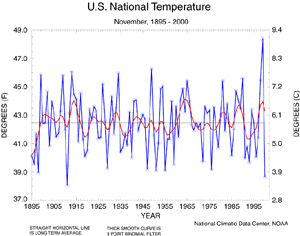 |
Contents of This Report:
- North American 500 mb Maps
- November National Temperature
- November National Precipitation
- January-November National Temperature
- January-November National Precipitation

The North American 500 mb Maps for November
The upper-air pattern during November consisted of negative height anomalies from coast to coast except for the extreme southeast from Louisiana to South Carolina.
Much below normal temperatures dominated the country from the central Plains to the Pacific coast while below normal temperatures dominated most of the rest of the country.
| The prevalent troughiness also provided wetter than normal conditions from the southern Rockies eastward to the south Atlantic coast and for the northern Plains. Areas from the Rockies westward and from the mid Atlantic northward were drier than normal. | 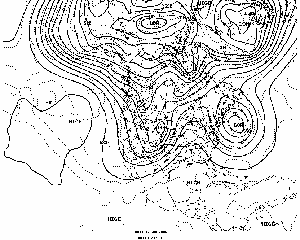 animation |
Additional information on hydrometeorological analysis and forecasting can be found at the Hydrometeorological Prediction Center's Web Page. The principles behind the 500 mb flow are briefly explained here.

National Temperature - November
 larger image |
The November 2000 monthly mean temperature averaged across the contiguous United States, based on data from the U.S. Historical Climate Network (USHCN) and preliminary data from the Climate Division Database, ranked as the second coolest November since records began in 1895. The preliminary nationally averaged temperature for November 2000 was 38.7° F, 3.8° F below the long-term mean. The actual November temperature values from 1895 through 2000 are available. November 1999, just last year, was the warmest such month on record. |
| The map to the right, based on approximately 250 airport stations, shows departures from the 1961-1990 normal temperatures for November 2000. In general, the country was cooler than normal except for areas around the central and western Great Lakes and portions of northern New England. Much cooler than normal conditions existed from the central Plains westward to the Pacific Coast. The persistent cooler than normal conditions are reflected in below-normal day-to-day temperature variability across most of the country. All of the Alaskan reporting stations were warmer than normal while most of the southern coastal sites were near normal. The Hawaiian stations averaged about normal. | 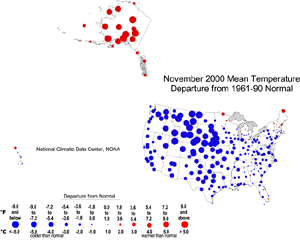 larger image |
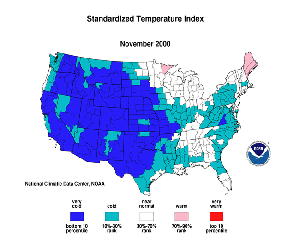 larger image |
The standardized temperature anomalies for November 2000 show abnormally cold conditions from the mid Mississippi Valley westward to the Pacific Coast. Cooler than normal conditions are depicted over much of the remaining third of the country. Near normal conditions are shown in the Tennessee Valley and the central and western Great Lakes region. This compares well with other temperature indicators. The map animation provided shows the geographical pattern of temperature anomalies for the last 12 months compared to a base period of 1931-1990. |
| Extreme minimum temperatures, interpolated from observations recorded at approximately 800 National Weather Service Stations for November 2000, reached values lower than -10° F over most of Wyoming, north central Colorado, northwestern Nebraska, east-central and southwestern Montana and portions of extreme western North Dakota. Below zero (F) temperatures were observed in portions of the Great Basin, northern Rockies, northern Plains, upstate New York and the mountains of northern New Hampshire. Reported low temperatures stayed above 30° F for the southern half of Florida, southern Louisiana, the southern third of Texas, portions of southern Arizona, and a good portion of the immediate Pacific coast from California to Oregon. The northern half of Alaska saw extreme minimum temperatures lower than -20° F while the extreme southeastern coast of Alaska remained above 10° F. Hawaiian stations remained above 50° F. | 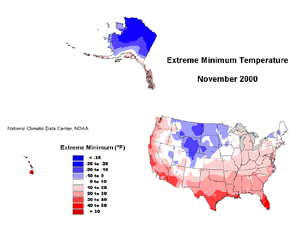 larger image |

National Precipitation - November
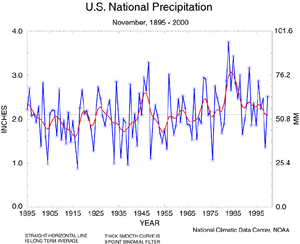 larger image |
Based upon preliminary precipitation data, November 2000 ranked as the 26th wettest such month since records began in 1895. Only five of the last 18 Novembers have averaged below the long-term mean. |
| The preliminary national standardized precipitation index ranked November 2000 as the 33rd wettest November since records began. | 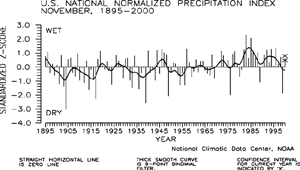 larger image |
| The map to the right, based on approximately 250 airport stations, shows November 2000 total precipitation as a departure from 1961-1990 station normals. Above-normal precipitation occurred over portions of central and western Alaska while below normal precipitation occurred over far northern, eastern, and southeastern portions of the state. The Hawaiian stations averaged slightly drier than normal. On the mainland U.S., stations were predominantly wetter than normal in the northern Great Plains states, most of Texas and New Mexico, southern Arizona and pockets in the southeast. Stations were drier than normal in most of the rest of the country. | 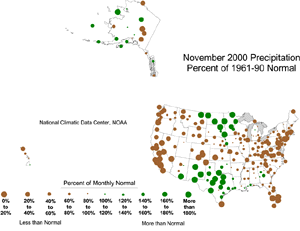 larger image |
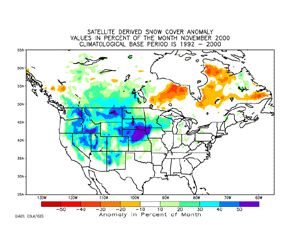 animation |
Snow cover duration for November 2000 exceeded the 1992-2000 average over most of the Rockies as well as the central Plains from south-central Nebraska to extreme southwestern Minnesota. |

National Temperature - January-November 2000
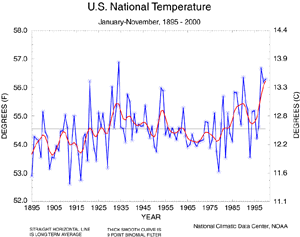 larger image |
The January-November 2000 mean temperature averaged across the contiguous United States, based on data from the U.S. Historical Climate Network (USHCN) and preliminary data from the Climate Division Database, ranked as the fourth warmest such eleven-month period since records began in 1895. The preliminary nationally averaged temperature for January-November 2000 was 56.3° F, 1.7° F above the long-term mean. The rate of temperature increase since 1895 is 0.93° F per century and 6.3° F per century since 1976. The last three such year-to-date periods have averaged much above the long term mean. The actual year-to-date data values from 1895 through 2000 are available. |
| Data collected by NOAA's TIROS-N polar-orbiting satellites and adjusted for time-dependent biases by NASA and the Global Hydrology and Climate Center at the University of Alabama in Huntsville indicate that temperatures in the lower half of the atmosphere (lowest 8 km) were the third warmest on record over the U.S. for the year-to-date period (January-November). The average lower tropospheric temperature over the continental U.S. during the January-November 2000 period was 0.48° F above the 1979-1998 long-term mean. | 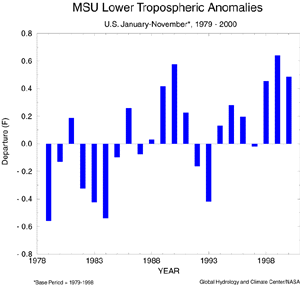 larger image |
National Precipitation - January-November 2000
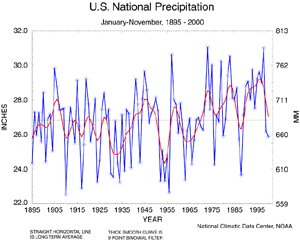 larger image |
Based upon preliminary precipitation data, January-November 2000 ranked as the 30th driest such eleven-month period since records began in 1895. About 10% of the country was much drier than normal while about six percent of the country was much wetter than normal. January-November 2000 is only the second such period in twelve years to average below the long-term mean. |
| The preliminary national standardized precipitation index ranked January-November 2000 as the 35th driest such eleven-month period since records began in 1895. | 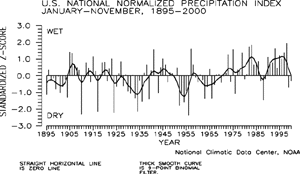 larger image |

Current data are based on preliminary reports from River Forecast Center stations and First and Second Order airport stations obtained from the National Weather Service (NWS) Climate Prediction Center and real time Global Telecommunications System (GTS) monthly CLIMAT summaries. THE CURRENT DATA SHOULD BE USED WITH CAUTION. These preliminary data are useful for estimating how current anomalies compare to the historical record, however the actual values and rankings for the current year may change as the final data arrive at NCDC and are processed.
The following NCDC datasets are used for the historical U.S. data: the climate division drought database (TD-9640), and the hurricane datasets (TD-9636 and TD-9697). It should be noted that the climate division drought database consists of monthly data for 344 climate divisions in the contiguous United States. These divisional values are calculated from the 6000+ station Cooperative Observer network.
 NOAA's National Centers for Environmental Information
NOAA's National Centers for Environmental Information